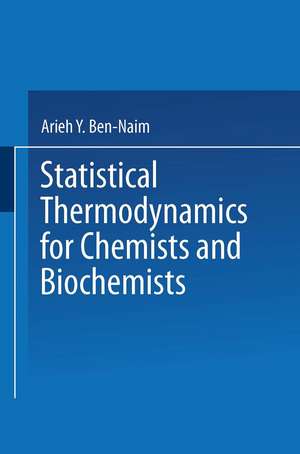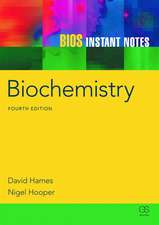Statistical Thermodynamics for Chemists and Biochemists
Autor Arieh Y. Ben-Naimen Limba Engleză Paperback – 27 apr 2013
Preț: 962.66 lei
Preț vechi: 1173.97 lei
-18% Nou
Puncte Express: 1444
Preț estimativ în valută:
184.23€ • 200.04$ • 154.75£
184.23€ • 200.04$ • 154.75£
Carte tipărită la comandă
Livrare economică 22 aprilie-06 mai
Preluare comenzi: 021 569.72.76
Specificații
ISBN-13: 9781475716009
ISBN-10: 1475716001
Pagini: 716
Ilustrații: XVIII, 697 p.
Dimensiuni: 152 x 229 x 38 mm
Greutate: 0.94 kg
Ediția:Softcover reprint of the original 1st ed. 1992
Editura: Springer Us
Colecția Springer
Locul publicării:New York, NY, United States
ISBN-10: 1475716001
Pagini: 716
Ilustrații: XVIII, 697 p.
Dimensiuni: 152 x 229 x 38 mm
Greutate: 0.94 kg
Ediția:Softcover reprint of the original 1st ed. 1992
Editura: Springer Us
Colecția Springer
Locul publicării:New York, NY, United States
Public țintă
ResearchDescriere
This book was planned and written with one central goal in mind: to demonstrate that statistical thermodynamics can be used successfully by a broad group of scientists, ranging from chemists through biochemists to biologists, who are not and do not intend to become specialists in statistical thermodynamics. The book is addressed mainly to gradu ate students and research scientists interested in designing experiments the results of which may be interpreted at the molecular level, or in interpreting such experimental results. It is not addressed to those who intend to practice statistical thermodynamics per se. With this goal in mind, I have expended a great deal of effort to make the book clear, readable, and, I hope, enjoyable. This does not necessarily mean that the book as a whole is easy to read. The first four chapters are very detailed. The last four become progressively more difficult to read, for several reasons. First, presuming that the reader has already acquired familiarity with the methods and arguments presented in the first part, I felt that similar arguments could be skipped later on, leaving the details to be filled in by the reader. Second, the systems themselves become progressively more com plicated as we proceed toward the last chapter.
Cuprins
The Fundamental Tools. Simple Systems without Interactions. Simple Systems with Interactions. One Dimensional Models. Theory of Liquids. Theory of Solutions. Water and Aqueous Solutions. Solvent Effects on Processes in Aqueous Solutions. Index.










